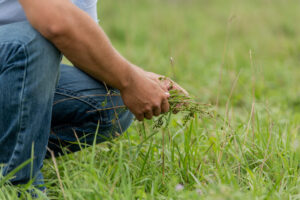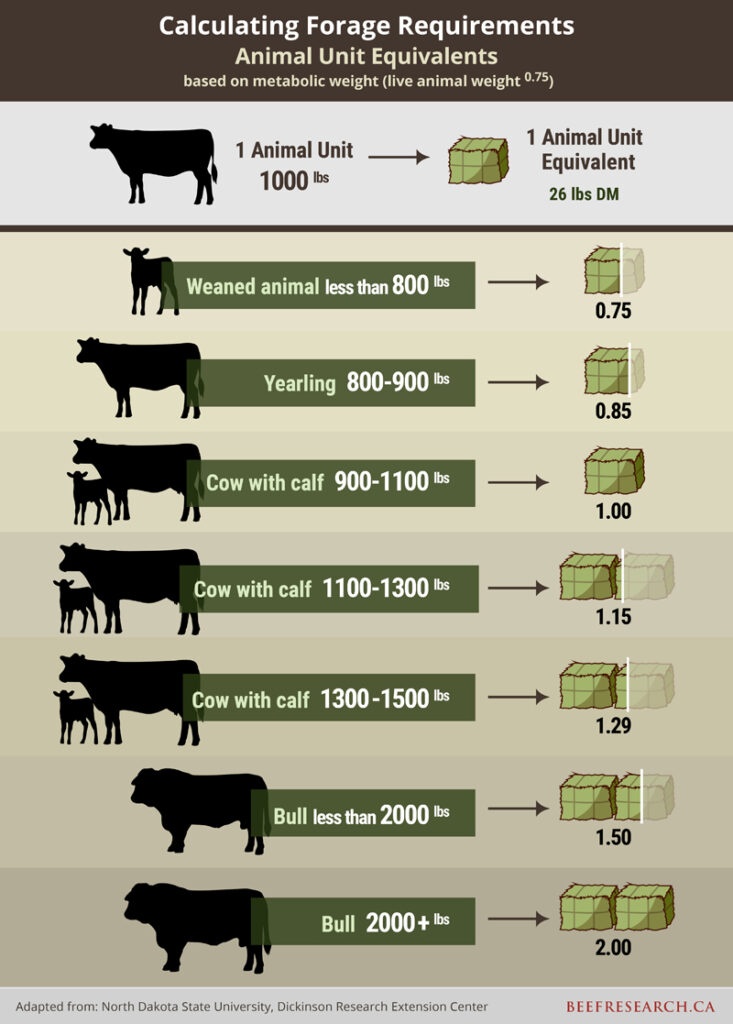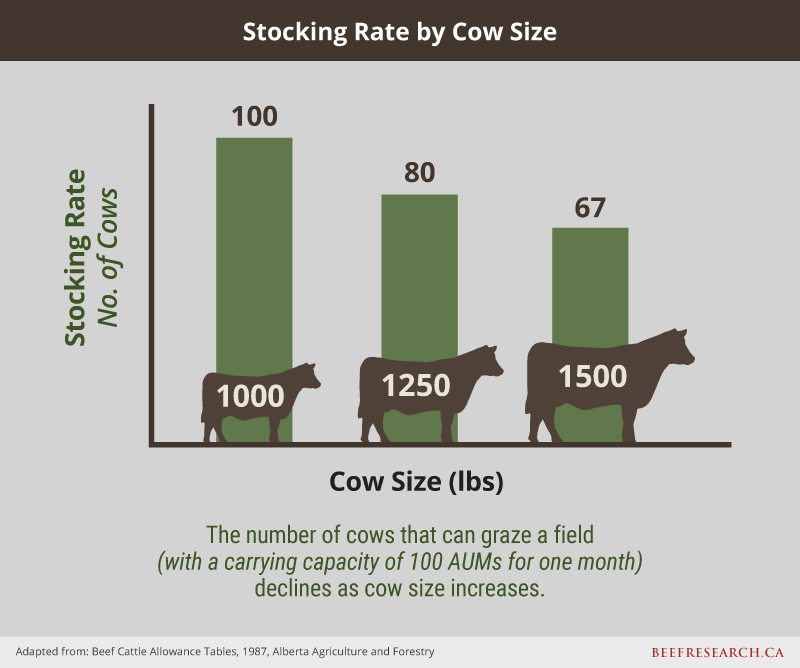
This Level 3 record-keeping module has been designed to build upon the modules covered in Forage & Grasslands Record-Keeping Level 1 and Level 2. These modules are designed to be used by a wide range of producers and management systems. The purpose of Level 3 is to dig deeper into analysis and application of collected farm data.
Pasture is a critical resource in the cattle industry. An effective management plan requires realistic production goals, a clear understanding of forage production, effective grazing strategies and timely responses to forage availability and changing environmental conditions.
For even more information about managing and planning grazing, visit the Pasture 101 resource.
Identifying Goals
One of the first steps in effective grazing management is to identify the goals for your production system. This includes profitability measures, lifestyle choices and biological outcomes such as soil health, forage production, ecosystem impacts and animal performance.
Some example goals may include:
- Improving stability of the grazing system by increasing drought preparedness
- Improving health and performance of native pastures
- Improving animal performance by matching forage demand with supply
- Adjusting the number of grazing days according to animal type (cow/calf pairs vs. yearlings)
This list is not exhaustive. Consider your own unique grazing management goals and situation.
The first principle of grazing management is to balance the available livestock demand with forage supply.
Livestock Forage Demand
Livestock forage demand accounts for the nutritional requirements of the animals that will be grazing and consuming the forage. Since animals of differing weights and stages of production have different requirements, this needs to be accounted for.
Animal Unit Equivalents (AUE) and Animal Unit Months (AUMs)

The animal unit (AU) is a standard unit used in calculating the relative grazing impact of different kinds and classes of livestock. One animal unit is defined as a 1000 lb (450 kg) beef cow with or without a nursing calf, with a daily dry matter forage requirement of 26 lb (11.8 kg).
An animal unit month (AUM) is the amount of forage to fulfill metabolic requirements by one animal unit for one month (30 days). One AUM is equal to 780 lbs (355 kg) of dry matter forage.
Because forage requirements change with the size and type of animal, an animal unit equivalent (AUE) is an adjustment to the standard animal unit that takes into account that not all animals weigh 1000 pounds. As a result, the amount of forage dry matter consumed is not always 26 pounds per day.
Data to record:
- Type and number of animals: the type of animals that will be grazing such as cow-calf pairs, yearlings, replacements and the number of animals will be required to calculate the grazing demand.
- Animal weights: weights will be required to determine what your animal unit equivalents are (1000 lb cows vs. 1500 lb cows).
When to record it:
- At turn out
- When animals are weighed
Example:
Typically, beef cows weigh anywhere from 1250 to 1500 pounds. Cows in this weight range can consume between 15 to 30 per cent more forage than the standard 1000-pound cow-calf pair that one Animal Unit Equivalent is based on.
For a group of cow-calf pairs the average weight is 1250 lbs. This means the animal unit equivalent for each pair is 1.15.
Total forage demand for one month for 100 cows averaging 1000 lbs, is less than that of a herd of 100 cows averaging 1,250 lbs. The number of animals that a pasture can hold (forage supply) will decrease as the size of each animal increases. For the 1250 lb cows, this number decreases from 100 to 80.
Determining the demand from the animal side is only one piece of a successful grazing management plan. To prepare a grazing plan, the supply of forage available for grazing also needs to be determined. Calculating the carrying capacity is one method to measure available forage.
Forage Supply Available
In Level 1, the records for pasture identification, pasture size, grass type, and range health were discussed. This information will be needed to determine the supply of forage available to balance with the demand from grazing animals. By ensuring there is adequate forage available for the number and size of cattle and for the length of time they will be grazing will avoid overstocking or overgrazing the pasture.
Calculating Carrying Capacity
When the demand is known, the supply can be managed to meet that demand. Carrying capacity (also known as grazing capacity) is the amount of forage available for grazing animals in a specific pasture or field.
Carrying capacity can be calculated using a variety of techniques. All of them depend on trial and error to some extent and should be monitored and adjusted over time. The carrying capacity for an individual year will vary from the long-term average for the pasture due to the annual environmental conditions, the class of cattle grazing, etc.
In Level 1, the data for pasture identification, pasture size, grass type, and range health were recorded. The BCRC Carrying Capacity Calculator will use this data to determine the available forage supply to meet animal demand.
| *Disclaimer |
|---|
| It is important to note that the ideal grazing situation is typically only ideal on paper. There are several factors that are involved in a grazing system therefore it is important to monitor and adjust accordingly. |
Forage supply (lbs/acre): The forage supply will be determined in steps 1 and 2 of the carrying capacity calculator. For these steps you will need to have the results from native or tame pasture assessments, which includes estimates for:
- Potential yield of the area (as a %)
- Production from desirable, adapted grass and legumes (as a %)
- Production from weeds or undesirable plants (as a %)
- Fertility program (average, above average, non-existent)
- Precipitation zone (mm/inches)
In step 3 of the carrying capacity calculator, total available forage is calculated using forage supply values, pasture size, and utilization rate.
Utilization rate: The utilization rate determines how much forage is used or lost to grazing, trampling, insects and wildlife. This helps determine how much forage material should be left behind to maintain future production. Utilizing pasture at a rate that exceeds the plant communities’ ability to recover can lead to lower forage production and encourage less palatable/productive forage plants to invade the pasture, including weeds. Recommended utilization rates for native pastures vary from 25-50%. For tame pastures, recommended utilization rates range from 50-75% depending on fertility.
The BCRC Carrying Capacity Calculator provides two methods: 1) estimates based on provincial guides and 2) field-based sampling.
Producers can use the Method 1 calculator if they wish to calculate an estimate of carrying capacity based on available provincial forage production guides. Using Method 1 is easy and works best when the pasture condition (or range health) is similar throughout the field and the forage plant community (or range type) is uniform.
Producers can use Method 2 if they plan on clipping, drying, and weighing samples collected from their pasture. Field-based sampling provides greater accuracy but requires more hands-on work. Producers may choose field-based sampling if provincial guides are unavailable for their region or if pasture types or conditions vary within their field. Forage production varies each year, so the Method 2 approach should include multiple years of sampling to estimate the long-term productivity of the pasture.
The following BCRC webinar provides step by step instructions on how to use both methods of the Carrying Capacity Calculator.
Data to record:
See Level 1, for the records for pasture identification, pasture size, grass type, and range health.
When to record it:
- Prior to turn out
Example:
The following video provides greater detail about using the carrying capacity calculator to determine total forage available, the corresponding number of animals that can graze the pasture, and the number of grazing days available.
This process of completing an inventory and evaluating resources is critical to developing and implementing a successful grazing system. The Pasture Planner: A Guide to Developing Your Grazing System provides an excellent resource to assist producers with planning, development and/or modification of their grazing system. It includes a number of worksheets and templates useful in the inventory and planning process.
Prepare a Grazing Plan
When the carrying capacity of various pastures are known, a grazing plan can start to take shape. In addition to this information, conducting a more in-depth inventory of resources is essential. Regardless of the pasture type, focusing on a few key principles can help maintain forage productivity, ensure stand longevity, sustain a healthy plant community, conserve water, and protect soils. In addition to balancing supply and demand, here are some points to consider:
- What is the relative yield and periods of growth for individual pastures throughout the grazing season?
- When is the best time to provide periods of rest and recovery for each pasture?
- Distribute grazing pressure across the pasture. When left on their own, cattle will prefer to graze moist, productive areas of a pasture and avoid dry hilltops where the forage quality may be lower.
- Which pastures will be needed and are best suited for a specific time period during the grazing season? Avoid grazing during sensitive times. Grazing too early can set a pasture back for the whole season.
- What physical infrastructure (e.g. fencing, water) is available or needed?
There are many different types of grazing systems promoted by groups and individual producers, including, but not limited to, rest-rotation, AMP (adaptive multi-paddock), intensive, or strip grazing. While each system has its own benefits and drawbacks, almost all systems factor in the key principles of grazing management.
Once a grazing plan has been implemented, it will be crucial to monitor and make changes to the plan as the grazing season progresses. Challenges such as drought, may require changes to stocking rates, adjusting rest periods, or providing alternative feed sources if needed. Flexibility is a key component of successful grazing management.
Watch the following BCRC webinar on the basics of developing a grazing plan.
- REFERENCES
Feedback
This content was last reviewed January 2020.
